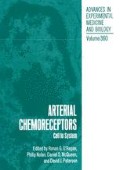Abstract
Some 25 years ago, Neil & O’Regan (1969, 1971) and Fidone & Sato (1970) demonstrated that electrical stimulation of the peripheral cut end of the carotid sinus nerve (CSN) inhibited spontaneous chemoreceptor activity recorded from nerve filaments split off from the main CSN trunk. These findings complemented the contemporary studies of Biscoe & Sampson (1968), who recorded spontaneous centrifugal neural activity from the central stump of the nerve, indicating the likely presence of an efferent or motor pathway in the CSN. Except for the finding that “efferent inhibition” of chemoreceptor discharge was mediated by unmyelinated, or C-fibers (Fidone & Sato, 1970), very little information has been forthcoming regarding the identity of the neurons or their mechanism of action in mediating this physiological phenomenon (O’Regan & Majcherczyk, 1983). McDonald & Mitchell (1981) postulated that efferent inhibition of the chemoreceptors was mediated by antidromic activity in afferent petrosal ganglion neurons, because the inhibitory effects persisted following chronic decentralization and sympathectomy. However, it was later pointed out that these careful surgical procedures would not have eliminated a group of presumptive autonomic neurons, first described by de Castro in 1926, which are present within the carotid body and along the CSN (see O’Regan & Majcherczyk, 1983, for review).
Access this chapter
Tax calculation will be finalised at checkout
Purchases are for personal use only
Preview
Unable to display preview. Download preview PDF.
References
Belmonte, C. &Eyzaguirre, C. (1974) Efferent influences on carotid body chemoreceptors. J. Neurophysiol. 37:1131–1143.
Biscoe, T.J. &Sampson, S.R. (1968) Rhythmical and non-rhythmical spontaneous activity recorded from the central cut end of the sinus nerve. J. Physiol. (Lond.) 196:327–338.
Bredt, D.S. &Snyder, S.H. (1989) Nitric oxide mediates glutamate-linked enhancement of cGMP levels in the cerebellum. Proc. Natl. Acad. Sci. USA 86:9030–9033.
Bredt, D.S. &Snyder, S.H. (1992) Nitric oxide, a novel neuronal messenger. Neuron 8:3–11.
De Castro, F. (1926) Sur la structure el l’innervation de la glande intercarotidienne (glomus caroticum) de rhomme et des mammiferes, et sur un nouveau Systeme d’innervation autonome du nerf glosopharyngien. Trabajos Lab. Invest. Biol. Univ. Madrid 24:365–432.
Fidone, S.J. &Sato, A. (1970) Efferent inhibition and antidromic depression of chemoreceptor A-fibers from the cat carotid body. Brain Res. 22:181–193.
Kondo, H. &Yamamoto, M. (1988) Occurrence, ontogeny, ultrastructure and some plasticity of CGRP (calcitonin gene-related peptide)-immunoreactive nerves in the carotid body of rats. Brain Res. 473:283–293.
Kummer, W. &Fischer, A. (1990) Tachykininergic axons in the guinea pig carotid body: origin, ultrastructure and coexistence with other peptides. In “Arterial Chemoreception,” C. Eyzaguirre, S.J. Fidone, R.S. Fitzgerald, S. Lahiri &D.M. McDonald, Springer-Verlag, New York, pp. 229–234.
McDonald, D.M. &Mitchell, R.A. (1981) The neural pathway involved in “efferent inhibition” of chemoreceptors in the cat carotid body. J. Comp. Neurol. 201:457–476.
Neil, E. &O’Regan R.G. (1969) Effects of sinus and aortic nerve efferents on arterial chemoreceptor function. J. Physiol. (Lond.) 200:69P–71P.
Neil, E. &O’Regan R.G. (1971) The effects of electrical stimulation of the distal end of the carotid sinus and aortic nerve on peripheral arterial chemoreceptor activity in the cat. J. Physiol. (Lond.) 215:15–32.
O’Regan, R.G. &Majcherczyk, S. (1983) Control of peripheral chemoreceptors by efferent nerves. In “Physiology of the Peripheral Arterial Chemoreceptors.” H. Acker &R.G. O’Regan, eds., Elsevier, pp. 257–298.
Stensaas, L.J. &Fidone, S.J. (1977) An ultrastructural study of cat petrosal ganglia: a search for autonomic ganglion cells. Brain Res. 124:29–39.
Wang, W.-J., Cheng, G.-F., Yoshizaki, K., Dinger, B. &Fidone, S. (1991a) The role of cyclic AMP in chemoreception in the rabbit carotid body. Brain Res. 540:96–104.
Wang, W.-J., He, L., Chen, J, Dinger, B. &Fidone, S. (1993a) Mechanisms underlying chemoreceptor inhibition induced by atrial natriuretic peptide in rabbit carotid body. J. Physiol. 460:427–441.
Wang, Z.-Z. ,Bredt, D.S., Fidone, S.J. &Stensaas, L.J. (1993b) Neurons synthesizing nitric oxide innervating the carotid body. J. Comp. Neurol. 336:419–432.
Wang, Z.-Z., Bredt, D.S., Dinger, B.G., Fidone, S.J. &Stensaas, L.J. (1993c) Localization and actions of nitric oxide in the cat carotid body. Neurosci. (in press).
Wang, Z.-Z. ,He, L., Stensaas, L.J., Dinger, B.G. &Fidone, S.J. (1991b) Localization and in vitro actions of atrial natriuretic peptide in the cat carotid body. J. Appl. Physiol. 70:942–946.
Wang, Z.-Z., Stensaas, L.J., Wang, W.-J., Dinger, B., de Vente, J. and Fidone, S.J. (1992) Atrial natriuretic peptide increases cyclic guanosine monophosphate immunoreactivity in the carotid body. Neurosci. 49:479–486.
Yamamoto, A., Kimura, S., Hasui, K., Fujisawa, Y., Tamaki, T., Fukui, K., Iwao, H. &Yonichi, A. (1988) Calcitonin gene-related peptide (CGRP) stimulates the release of atrial natriuretic peptide (ANP) from isolated rat atria. Biochem. Biophys. Res. Comm. 155:1452–1458.
Author information
Authors and Affiliations
Editor information
Editors and Affiliations
Rights and permissions
Copyright information
© 1994 Springer Science+Business Media New York
About this chapter
Cite this chapter
Wang, ZZ., Stensaas, L.J., Bredt, D.S., Dinger, B.G., Fidone, S.J. (1994). Mechanisms of Carotid Body Inhibition. In: O’Regan, R.G., Nolan, P., McQueen, D.S., Paterson, D.J. (eds) Arterial Chemoreceptors. Advances in Experimental Medicine and Biology, vol 360. Springer, Boston, MA. https://doi.org/10.1007/978-1-4615-2572-1_35
Download citation
DOI: https://doi.org/10.1007/978-1-4615-2572-1_35
Publisher Name: Springer, Boston, MA
Print ISBN: 978-1-4613-6099-5
Online ISBN: 978-1-4615-2572-1
eBook Packages: Springer Book Archive

